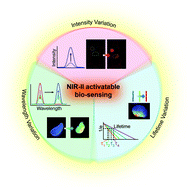Activatable fluorescence sensors for in vivo bio-detection in the second near-infrared window
Abstract
Fluorescence imaging in the second near-infrared (NIR-II, 1000–1700 nm) window has exhibited advantages of high optical resolution at deeper penetration (ca. 5–20 mm) in bio-tissues owing to the reduced photon scattering, absorption and tissue autofluorescence. However, the non-responsive and “always on” sensors lack the ability of selective imaging of lesion areas, leading to the low signal-to-background ratio (SBR) and poor sensitivity during bio-detection. In contrast, activatable sensors show signal variation in fluorescence intensity, spectral wavelength and fluorescence lifetime after responding to the micro-environment stimuli, leading to the high detection sensitivity and reliability in bio-sensing. This minireview summarizes the design and detection ability of recently reported NIR-II activatable sensors. Furthermore, the challenges, opportunities and prospects of NIR-II activatable bio-sensing are also discussed.

- This article is part of the themed collections: Most popular 2021 analytical chemistry articles, 2021 and Near-infrared (NIR) luminescent probes for bioimaging and biosensing


 Please wait while we load your content...
Please wait while we load your content...